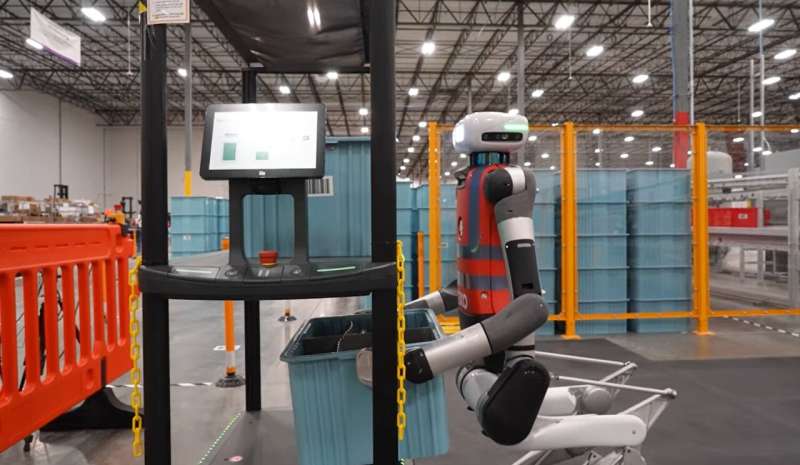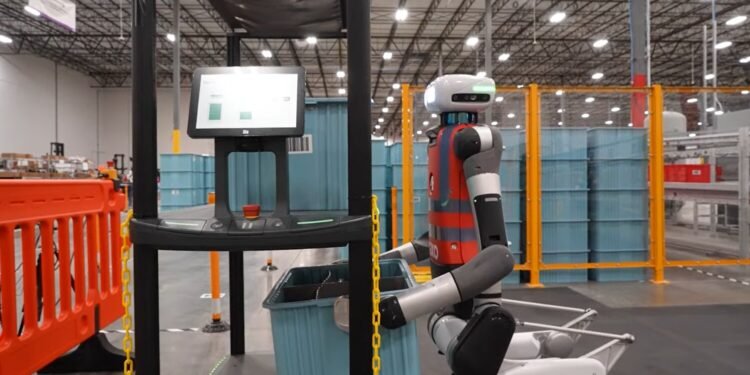by Michael E. Kanell, The Atlanta Journal-Constitution

In what GXO Logistics calls “a proof-of-concept pilot,” a human-centric machine by that name is moving tote boxes in a Spanx warehouse in Flowery Branch, Georgia, that is managed by the global, Connecticut-based company. The 5-foot, 9-inch robot does “repetitive tasks” in a warehouse like moving items onto conveyor belts, according to GXO spokeswoman Fallon McLoughlin.
The idea, the company says, is to see how well the robot does those tasks, potentially freeing humans to do other, more valuable things. And as the program advances, the machine will take on more roles.
“The beauty of Digit is that it’s multi-purpose, so it can learn new tasks as needed, instead of needing new versions of the robot for different tasks,” McLoughlin said.
Robots have been part of American factories for decades. But they mostly do not walk on two legs, lift boxes with two arms and turn a head to direct their two eyes.
In other words, they mostly look just like machines.
Digit-the-robot is humanoid, the “first multi-purpose, human-centric robot that is made for work,” according to a statement from Agility Robotics, the Oregon-based company that made the machine.
While it’s called a pilot program, the machine is doing some of that work already, said McLoughlin.
“If you ordered a Spanx product over the last few weeks, Digit might have handled it,” she said.
Economists and others have long speculated on the future of human workers when cheaper, more durable, more replaceable machines are available for many physical tasks. The much-ballyhooed advent of AI—artificial intelligence—only ratchets up the possibilities.
Some futurists with a dystopian bent have maintained that inevitable technological improvements will give machines so many capabilities that they will effectively displace a significant part of the workforce.
Agility declined to say how much Digit-the-robot cost.
But according to Bloomberg News, which estimated its cost against a lifespan of about 20,000 hours, it costs about $10 to $12 an hour to operate, already less than the median pay of a warehouse worker. The company said increased production of the machines will dramatically cut that cost.
Asked about whether the robot is cheaper than human workers, an Agility spokesperson said, “We don’t look at it that way. The deployment of Digit is designed to help employees by removing one repetitive task from their workflow so they can focus on more complex work.”
Agility wants to build robot partners that “augment the human workforce, ultimately enabling humans to be more human,” according to a statement from the Oregon-based company.
Optimists maintain that machines are an economic complement to people, dramatically improving productivity and standards of living. While machines have already replaced humans in many tasks, people have thus far continued working in record numbers, moving to different roles the way they did when automation came to farms and factories a century or more ago.
But with technology rapidly evolving, some experts say the outcome is uncertain.
And hovering over it all is the ghost of Asimov, who wrote stories in which robots were helpful, some in which they were dangerous and at least one in which they were indistinguishable from humans.
Whatever the future, it is on the way: Agility said that it is opening “a humanoid robot factory” early next year. The factory will have the capacity to produce 10,000 robots a year.
More information:
gxo.com/news_article/gxo-condu … human-centric-robot/
2023 The Atlanta Journal-Constitution. Distributed by Tribune Content Agency, LLC.
Citation:
Humanoid robot working in a Spanx warehouse (2023, December 13)
retrieved 16 December 2023
from https://techxplore.com/news/2023-12-humanoid-robot-spanx-warehouse.html
This document is subject to copyright. Apart from any fair dealing for the purpose of private study or research, no
part may be reproduced without the written permission. The content is provided for information purposes only.










